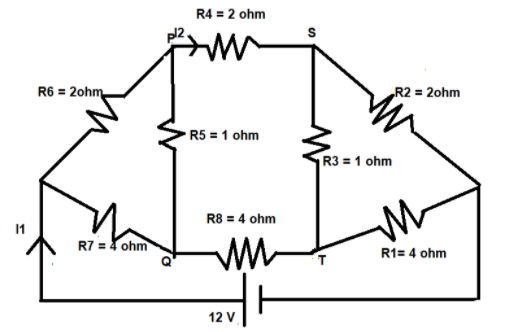
Answer
460.8k+ views
Hint: In series-parallel circuits the Wheatstone bridge condition can be applied to simply the problem. Applying the necessary conditions, we can find the equivalent resistance of the circuit and find the current through each resistance and through the entire circuit.
Complete answer:
The Wheatstone’s bridge condition states that if two or more parallel resistances in equal ratios have a parallel resistor across them, then the current flowing the latter will be zero.
Let us employ this condition in our circuit. We can see that the pair of resistances (R2, R1), (R4, R8) and (R6, R7) are in the ratio 1:2 to each other.
i.e., \[\dfrac{R2}{R1}=\dfrac{R4}{R8}=\dfrac{R6}{R7}=\dfrac{1}{2}\]
Thus, the Wheatstone’s bridge condition is valid here.
This gives in that the resistances R3 and R5 have no role in this circuit. The equivalent circuit will be –

Now, let us calculate the equivalent resistance of the circuit. R2, R4, R6 and R1, R8, R7 are in series with each other.
i.e.,
\[\begin{align}
& \Rightarrow {{R}_{s1}}=R2+R4+R6 \\
& \text{ =2+2+2} \\
& \text{ =6}\Omega \\
& \text{ }and \\
& \text{ }{{R}_{s2}}=R1+R8+R7 \\
& \text{ = 4+4+4} \\
& \text{ =12}\Omega \\
& \dfrac{1}{{{R}_{eq}}}=\dfrac{1}{R}=\dfrac{1}{{{R}_{s1}}}+\dfrac{1}{{{R}_{s2}}} \\
& \Rightarrow \dfrac{1}{R}=\dfrac{12+6}{6\times 12} \\
& \Rightarrow R=4\Omega \\
\end{align}\]
Now, we can find the current through the circuit. The total current ${I_1}$ is given by –\[{I_1}=\dfrac{V}{R}=\dfrac{12}{4}=3A\] --(1)
Current ${I_2}$ is the current passing through the upper hand of the circuit. We can apply the current divider rule to find ${I_2}$.
i.e.,
\[\begin{align}
& \text{ }{I_1}={{I}_{total}}\times \dfrac{{{R}_{2}}}{{{R}_{1}}+{{R}_{2}}} \\
& \Rightarrow {I_2}={I_1}\times \dfrac{{{R}_{s2}}}{{{R}_{s1}}+{{R}_{s2}}} \\
& \Rightarrow {I_2}=3\times \dfrac{12}{6+12} \\
& \text{ =3}\times \dfrac{2}{3} \\
& \therefore {I_2}=2A \\
\end{align}\]
So, we can conclude that –
a) The current ${I_1}$ is 3A.
b) The current ${I_2}$ is 2A.
c) Current doesn’t pass through PQ and ST.
The correct answers are given by options A, B and D.
Note:
We can find the current in the circuit after applying Wheatstone’s condition using the Voltage-divider rule also. We find the voltages across the resistors in series connections and find the current in them. The method we have used is more convenient for this question.
The points P, Q, S and T are equipotential points in the circuit.
Complete answer:
The Wheatstone’s bridge condition states that if two or more parallel resistances in equal ratios have a parallel resistor across them, then the current flowing the latter will be zero.
Let us employ this condition in our circuit. We can see that the pair of resistances (R2, R1), (R4, R8) and (R6, R7) are in the ratio 1:2 to each other.
i.e., \[\dfrac{R2}{R1}=\dfrac{R4}{R8}=\dfrac{R6}{R7}=\dfrac{1}{2}\]
Thus, the Wheatstone’s bridge condition is valid here.
This gives in that the resistances R3 and R5 have no role in this circuit. The equivalent circuit will be –

Now, let us calculate the equivalent resistance of the circuit. R2, R4, R6 and R1, R8, R7 are in series with each other.
i.e.,
\[\begin{align}
& \Rightarrow {{R}_{s1}}=R2+R4+R6 \\
& \text{ =2+2+2} \\
& \text{ =6}\Omega \\
& \text{ }and \\
& \text{ }{{R}_{s2}}=R1+R8+R7 \\
& \text{ = 4+4+4} \\
& \text{ =12}\Omega \\
& \dfrac{1}{{{R}_{eq}}}=\dfrac{1}{R}=\dfrac{1}{{{R}_{s1}}}+\dfrac{1}{{{R}_{s2}}} \\
& \Rightarrow \dfrac{1}{R}=\dfrac{12+6}{6\times 12} \\
& \Rightarrow R=4\Omega \\
\end{align}\]
Now, we can find the current through the circuit. The total current ${I_1}$ is given by –\[{I_1}=\dfrac{V}{R}=\dfrac{12}{4}=3A\] --(1)
Current ${I_2}$ is the current passing through the upper hand of the circuit. We can apply the current divider rule to find ${I_2}$.
i.e.,
\[\begin{align}
& \text{ }{I_1}={{I}_{total}}\times \dfrac{{{R}_{2}}}{{{R}_{1}}+{{R}_{2}}} \\
& \Rightarrow {I_2}={I_1}\times \dfrac{{{R}_{s2}}}{{{R}_{s1}}+{{R}_{s2}}} \\
& \Rightarrow {I_2}=3\times \dfrac{12}{6+12} \\
& \text{ =3}\times \dfrac{2}{3} \\
& \therefore {I_2}=2A \\
\end{align}\]
So, we can conclude that –
a) The current ${I_1}$ is 3A.
b) The current ${I_2}$ is 2A.
c) Current doesn’t pass through PQ and ST.
The correct answers are given by options A, B and D.
Note:
We can find the current in the circuit after applying Wheatstone’s condition using the Voltage-divider rule also. We find the voltages across the resistors in series connections and find the current in them. The method we have used is more convenient for this question.
The points P, Q, S and T are equipotential points in the circuit.
Recently Updated Pages
Fill in the blanks with suitable prepositions Break class 10 english CBSE

Fill in the blanks with suitable articles Tribune is class 10 english CBSE

Rearrange the following words and phrases to form a class 10 english CBSE

Select the opposite of the given word Permit aGive class 10 english CBSE

Fill in the blank with the most appropriate option class 10 english CBSE

Some places have oneline notices Which option is a class 10 english CBSE

Trending doubts
Fill the blanks with the suitable prepositions 1 The class 9 english CBSE

How do you graph the function fx 4x class 9 maths CBSE

When was Karauli Praja Mandal established 11934 21936 class 10 social science CBSE

Which are the Top 10 Largest Countries of the World?

What is the definite integral of zero a constant b class 12 maths CBSE

Why is steel more elastic than rubber class 11 physics CBSE

Distinguish between the following Ferrous and nonferrous class 9 social science CBSE

The Equation xxx + 2 is Satisfied when x is Equal to Class 10 Maths

Differentiate between homogeneous and heterogeneous class 12 chemistry CBSE





